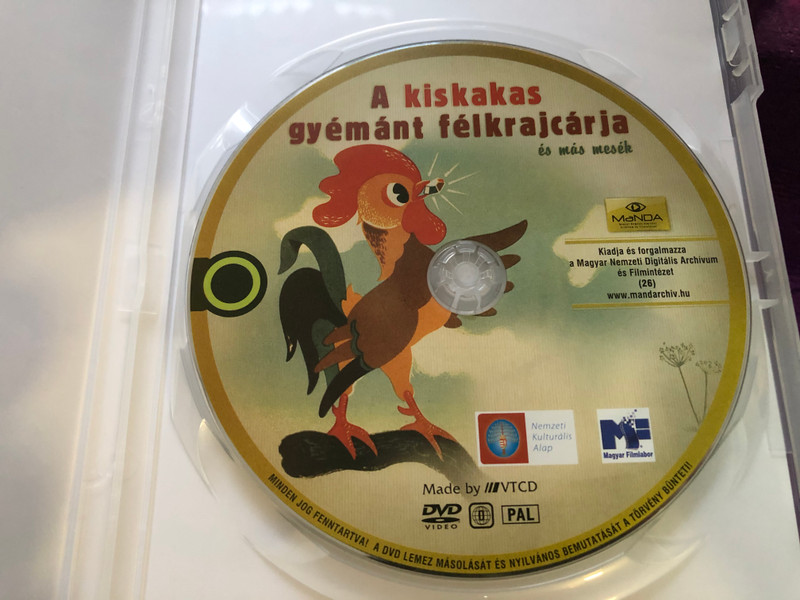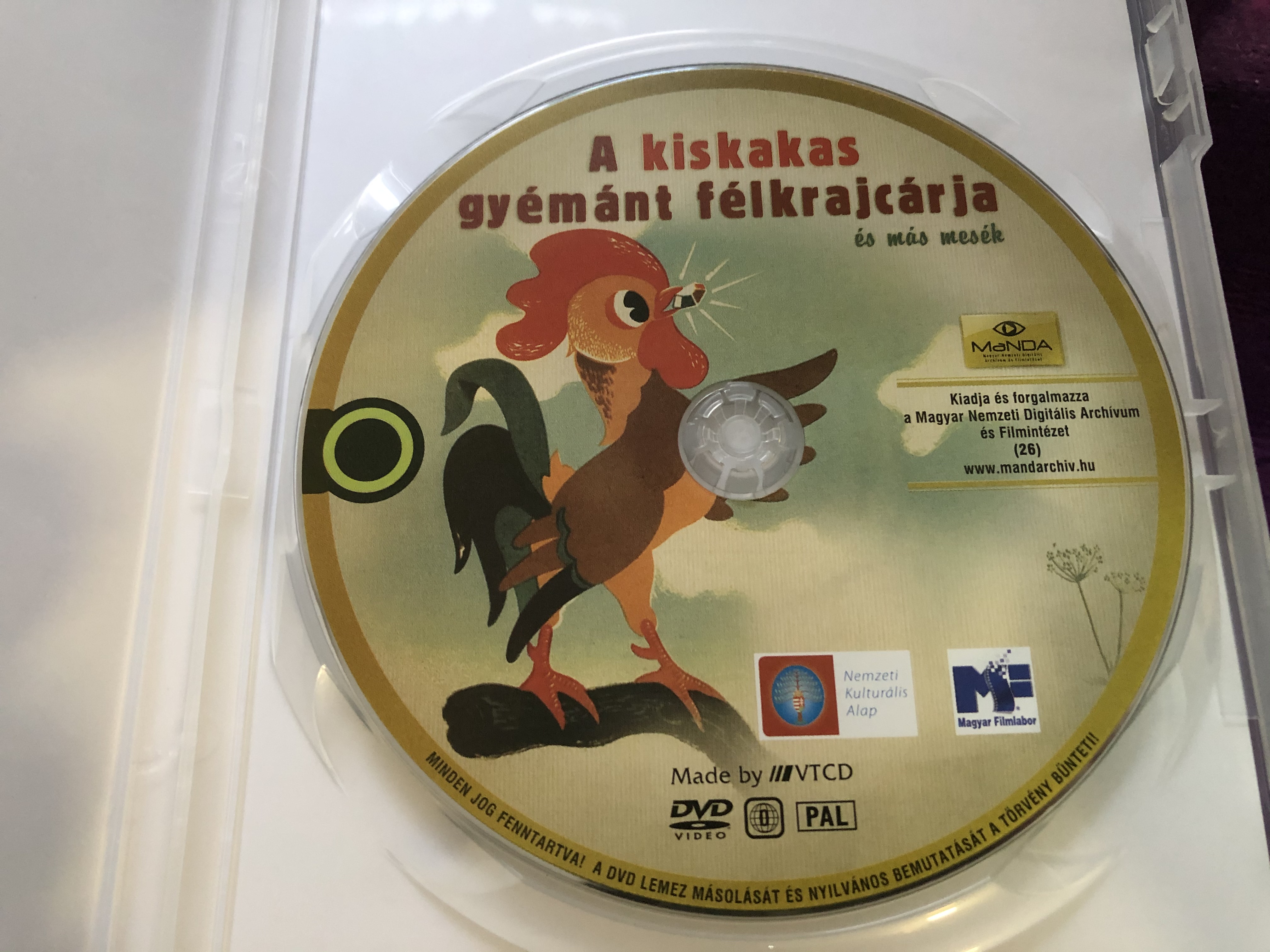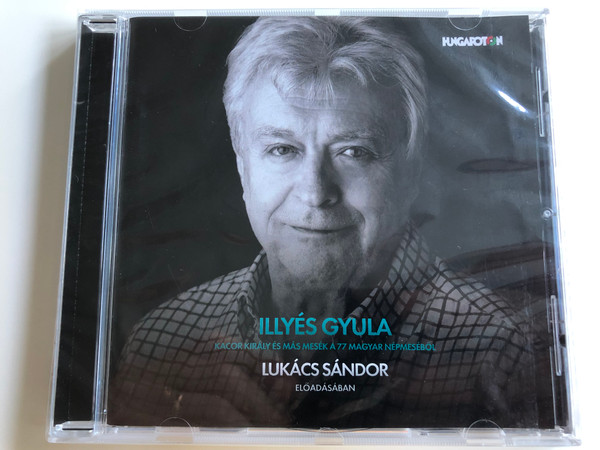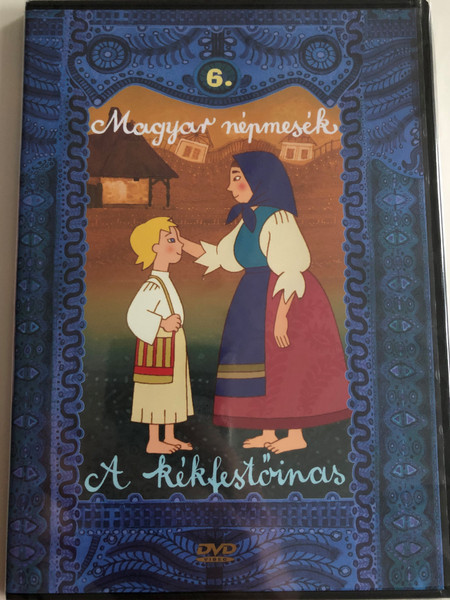Description
A kiskakas gyémánt félkrajcárja és más mesék DVD 2012 - 7 Hungarian folk tales for children / Directed by Macskássy Gyula / Két bors ökröcske, Erdei sportverseny, Ceruza és radír, Párbaj, A számok története, Romantikus történet
UPC 5999884681236
REGION 0 PAL DVD (ALL REGIONS)
MADE IN HUNGARY
AUDIO: Hungarian 2.0
SUBTITLES: English
TOTAL RUNTIME: 91 MINUTES
English Summary:
For the 100th anniversary of the birth of Gyula Macskássy, the father of Hungarian animation, the first selection of the DVD series presenting the director's fairy tales and unique animated films was published by the Hungarian National Digital Archive. Lovely classics are added to the family's storybook library, such as The Rooster Diamond Half-Crank (1951) or The Two Pepper Bulls (1956).
“Deep to say and popular way of performing”: this was the ars poetica of Gyula Macskássy. Although animated film experiments took place in Hungary long before his operation, the world was amazed by the uniqueness of Hungarian animated film through his works. At the beginning of the 1930s, Macskássy's career started from Sándor Bortnyik's private school Bauhausos, Műhely. At the age of 20, he founded Coloriton Studio in Budapest, specializing in advertising graphics and motion pictures, with two groupmates, János Halász (later John Halas) and Félix Kassowitz. During the works created here, the cartoonistic, striking visual style that defined Macskássy's entire career was formed. The cockscomb diamond was greeted at home in 1951 as the first colorful Hungarian cartoon. This little “winged Robin Hood tale” was followed in line by Two Pepper Bulls, Dog Obligation and The Forest Sports Competition. After the classic fairy tale films made during the heroic era of state cartoon production, there was a sharp turn in the career of both Hungarian animation and Gyula Macskássy. The world of children’s tales has been replaced by stories placed in today’s environment. In the films made in the fifties and sixties, the “boldly simplified form language based on the refined play of stylized forms” appeared in Macskássy's formulation, which was the key to the growing of Hungarian animation. The “kindly naive humanist” films, Pencil and Eraser, and the Duel, co-written with graphic artist György Várnai, paved the way for domestic cartoon abroad - the former in Karlovy Vary, the latter in Cannes and Oberhausen with festival awards. Whether it's classic fairy tale adaptations or humanist gag films, with all the works of Gyula Macskássy - in the words of Attila Dargay - he "tried to save the dignity of our destiny with beauty".
Content:
The Diamond of the Rooster (1951)
Forest sports competition (1952)
Dog Obligation (1953)
Two Pepper Bulls (1954)
Pencil and eraser (1960)
Duel (1960)
History of Numbers (1962)
Romantic Story (1964)
Hungarian Summary:
A magyar animáció atyja, Macskássy Gyula születésének 100. évfordulójára a Magyar Nemzeti Digitális Archívum gondozásában jelent meg a rendező mesefilmjeit és egyedi animációs filmjeit bemutató DVD-sorozat első válogatása. Olyan kedves klasszikusokkal egészül ki a családi mesefilm-tár, mint A kiskakas gyémánt félkrajcárja (1951), vagy a Két bors ökröcske (1956).
„Mély mondanivaló és populáris előadásmód”: ez volt Macskássy Gyula ars poeticája. Noha Magyarországon már jóval az ő működése előtt is születtek animált filmkísérletek, mégis, a világ az ő művein keresztül csodálkozott rá a magyar animációs film egyediségére. Macskássy pályája a harmincas évek elején Bortnyik Sándor Bauhausos magántanodájából, a Műhelyből indult. 20 évesen két csoporttársával, Halász Jánossal (a későbbi John Halas-szal) és Kassowitz Félixszel alapította Budapesten a reklámgrafikákra és mozgóképes hirdetésekre szakosodott Coloriton Stúdiót. Az itt készített munkák során formálódott az a karikaturisztikus, markáns vizuális stílus, amely Macskássy egész pályafutását meghatározta.
A kiskakas gyémánt félkrajcárját 1951-ben az első színes magyar rajzfilmként üdvözölték itthon. E kis „szárnyas Robin Hood–mesét” a Két bors ökröcske, a Kutyakötelesség és Az erdei sportverseny követte a sorban. Az állami rajzfilmgyártás hőskorszakában készített klasszikus mesefilmek után éles fordulat következett be mind a magyar animáció, mind Macskássy Gyula pályáján. A gyermekmesék világát mai környezetbe helyezett történetek váltották fel. Az ötvenes-hatvanas fordulóján készült filmekben megjelent az a – Macskássy megfogalmazásában – „stilizált formák rafinált játékára épülő, merészen leegyszerűsített formanyelv”, amely a magyar animáció felnőtté válásának volt a záloga. A Várnai György grafikussal közösen jegyzett, „kedvesen naiv humanista” filmek, a Ceruza és radír, valamint a Párbaj utat nyitottak a külföld felé a hazai rajzfilm számára – az előbbit Karlovy Varyban, az utóbbit Cannes-ban és Oberhausenban is fesztiváldíjakkal ismerték el.
Legyen szó a klasszikus meseadaptációkról vagy a humanista gegfilmekről, Macskássy Gyula minden alkotásával – Dargay Attila szavaival élve – „a szépséggel próbálta menteni sorsunk méltóságát”.
Tartalom:
A kiskakas gyémánt félkrajcárja (1951)
Erdei sportverseny (1952)
Kutyakötelesség (1953)
Két bors ökröcske (1954)
Ceruza és radír (1960)
Párbaj (1960)
A számok története (1962)
Romantikus történet (1964)


























